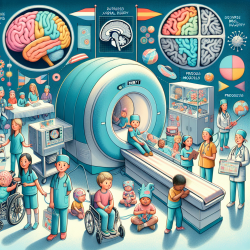Exploring the Impact of MRI on Pediatric Traumatic Brain Injury Outcomes
In the realm of pediatric traumatic brain injury (TBI), ensuring optimal outcomes for children is of utmost importance. A recent study titled "Diffuse Axonal Injury Grade on Early MRI is Associated with Worse Outcome in Children with Moderate-Severe Traumatic Brain Injury" sheds light on the potential of MRI in predicting outcomes for children with moderate to severe TBI (msTBI). This blog delves into the study's findings and explores how practitioners can enhance their skills and treatment strategies by leveraging these insights.
Key Findings from the Study
The study focused on pediatric patients with msTBI who underwent MRI within 30 days of injury. The primary outcome measure was the Pediatric Cerebral Performance Category Scale (PCPCS) score at six months post-injury. The study revealed several important insights:
- A higher Diffuse Axonal Injury (DAI) grade on early MRI was associated with worse functional outcomes at six months.
- DAI grade correlated with discharge to inpatient rehabilitation, indicating a need for extended care.
- However, when controlling for core clinical variables like the Glasgow Coma Scale (GCS) score, the DAI grade did not independently predict outcomes.
Implications for Practitioners
For practitioners, these findings underscore the importance of incorporating MRI into the assessment process for pediatric TBI. Here are some ways practitioners can utilize these insights:
- Enhanced Prognostication: Understanding the correlation between DAI grade and outcomes can aid in setting realistic expectations and planning appropriate interventions.
- Tailored Rehabilitation Plans: Recognizing the need for inpatient rehabilitation based on DAI grade can help in designing personalized rehabilitation programs for better recovery.
- Further Research: The study highlights the need for further research to explore additional MRI biomarkers that might enhance prognostic accuracy.
Encouraging Further Research
While the study provides valuable insights, it also opens avenues for further research. Practitioners are encouraged to explore additional MRI biomarkers and their potential in improving outcome predictions. Collaborative research efforts can lead to the development of more comprehensive prognostic models that incorporate both clinical and imaging data.
Moreover, understanding the limitations of current models, such as the IMPACT model, and seeking ways to enhance them with MRI findings can significantly contribute to the field. This pursuit of knowledge and innovation is crucial for advancing pediatric TBI care.
Conclusion
The study on DAI grade and its association with outcomes in pediatric TBI patients highlights the potential of MRI as a valuable tool in prognostication. By integrating MRI findings into clinical practice, practitioners can improve their skills, tailor interventions, and ultimately create better outcomes for children. As we continue to explore the role of MRI in pediatric TBI, further research will be key to unlocking its full potential.
To read the original research paper, please follow this link: Diffuse Axonal Injury Grade on Early MRI is Associated with Worse Outcome in Children with Moderate-Severe Traumatic Brain Injury.










